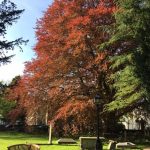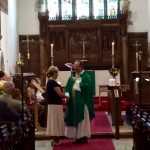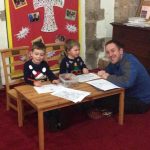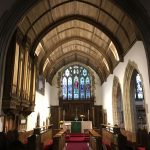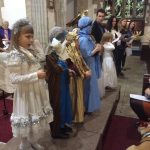St. Cadoc’s church stands in the centre of the Roman Legionary Fortress of Isca, over the headquarters building, or principia, where the legionary standards were kept and statues of the Roman Emperors venerated.
Entering Caerleon across the bridge over the River Usk the Roman traveller would come up the main central road of the fortress, roughly in line with the present High Street, to a central crossroads that is still preserved in the present day street plan.
In front, in the area of the modern churchyard was a great open courtyard or piazza with the main headquarters building behind it. It was in the centre of this courtyard that St. Cadoc’s was built, though the Roman principia would have long been in ruins.
The first church, as we know it today, was probably built in pre-Norman times and constructed of wood, as were nearly all Welsh churches at that time. The Norman church, believed to have replaced its predecessor in the latter part of the 12th century, was built of stone. In the late Middle ages, Caerleon was a prosperous port and market town and about that time the church was almost entirely rebuilt on a larger scale having a west tower, a broad nave with north and south aisles and a chancel.
A feature of the interior of the church, with a capacity of around 350, is its noble proportions and symmetry with graceful arches and stained glass windows. Nine of the windows depict the New Testament Gospel story in sequence and are dedicated to the memory of Charles Williams and formed part of a major restoration undertaken in 1867.
The organ was built between 1883 and 1885 by Peter Conacher of Huddersfield. In 1952 it was rebuilt and the original tracker action was replaced with a tubular pneumatic action. At the same time a front case was added. Over the years further improvements have been made, most recently in 2001 when it was changed to a direct electric magnetic action.

- One of our beautiful stained glass windows commemorating a former church organist.
- It’s not just the Youngsters who enjoy our Children’s corner!
- Our congratulations to newly weds Helen and Huw as they begin married life together
- Sunday School Performance
- Sunday School Performance
The church tower has a full octave of eight bells and each bell is mounted on a wooden wheel for full circle ringing.
Overall, the fabric of the church is in very good order, as is the churchyard. The former is cleaned weekly and the latter tended regularly, both by teams of volunteers. The church room, situated at the rear of the churchyard, can accommodate a maximum of 40 people and is for hire. It has full disabled access ramp, toilet facilities and a modern kitchen – rated five-star in a recent health and safety inspection undertaken by the local authority.
The age range of those attending is 0 to 90 plus years and the services comprise both traditional and contemporary liturgies. The 1984 version is used on Sundays at 8.00am, and on Wednesdays 10.30am. The 2004 version is used at other Sunday and special services.
Music plays a very important part. We have a four part (SATB) RSCM affiliated choir which leads the congregation at our regular sung Eucharist and Evensong services. An anthem is sung at each Sunday service and we possess an extensive library of choral music from Tye to Tallis and Mozart to Mathias. Hymns Old and New was our regular Hymn book but Common Praise has been introduced recently and is proving very popular.
We give communion at the Eleanor Hodson and Caerleon House Nursing Homes and also visit those at home.
For all enquiries please contact our administrator, Claire Cowper:
Sue Batey 01633 430259; sbatey.stcadocs@gmail.com
Tim Ford 07305638533 / 07711683454.; fordtim1968@gmail.com

